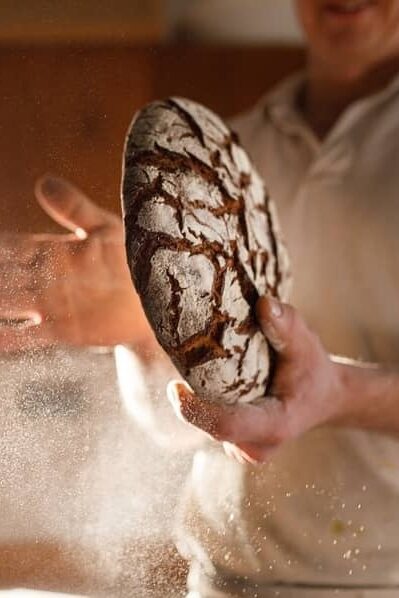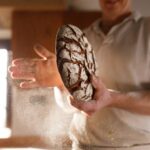We use cookies to make your experience better. To comply with the new e-Privacy directive, we need to ask for your consent to set the cookies. Learn more.
Flour Power

Grain is an amazing food – beautifully packaged in its exterior wrapping of bran it will keep for a very long time. Once milled its nutritious bounty is made available for us to enjoy as flour and with the magic of fermentation this is transformed into our daily bread. A blessing indeed - especially if you step out of the shadow of wheat and explore all the other grains that are available.
Grain – not just wheat Modern wheat has got rid of thecompetition on the grain front – why?
Wheat is high yielding, easy to harvest, does not require a special (often expensive) de- husking process, does not shed seed onto the ground before harvest and contains significant amounts of gluten. Wheat is a modern food grown to meet the needs of a large, modern society. For example, the higher amounts of gluten in wheat became of greater importance as the western world industrialised and changed its eating habits. Bread was in and thick stews -which suited the ancient grains –were out. The growth of the agri-chemical industry also meant that it was no longer necessary for grain to be protected from insects and fungus by a thick husk - chemicals could do that job. The comparatively low yields of ancient grains also meant that in the face of population growth they could not feed the masses. There is no doubt that wheat is a very nutritious food that has enabled societies to grow but there is still a place for the obscure relatives at the table. By consuming these grains we are ensuring that they will survive and contribute to diversity within the grain field! All the grain at Fruit Hill Farm is organic and available in 1kg, 5kg and 25kg sacks.
Einkorn Triticum monococcum Einkorn is the earliest type of farmed wheat and is said to have been developed by farmers in the Middle East over 20,000 years ago. Although einkorn is adaptable to a wide range of soil conditions, it has a very low yield.
Golden in colour, einkorn has a delicate earthy flavour. It produces very fine flour perfect for biscuits, pancakes and other batters. It can be used as you would wheat but its weaker gluten tends to make dough that is stickier, less pliable and does not tolerate being overworked.
- Einkorn is the only wheat never hybridized and has only two sets of chromosomes.
- Its weaker gluten makes it easier to digest.
- It is higher in protein and lower in carbohydrates than modern wheat.
- It is richer in carotenoids, B vitamins, and essential and trace minerals than modern wheat.
Spelt is a species of wheat cultivated since 5000 BC. Spelt was an important staple in parts of Europe from the Bronze Age to medieval times. Spelt berries have a very hard hull that has to be removed before milling. This requires specialist machinery and makes the final product more expensive.
Just like wheat, barley, and rye, spelt is a whole grain that's packed with fibre and nutrients. Spelt contains higher mineral counts of copper, zinc, and manganese, as well as a lower percentage of the anti-nutrient phytic acid than wheat. Spelt also has lower amount of gluten and fructans (a type of carbohydrate) than wheat making it more tolerant for people with digestive issues.

Light Rye Rye varieties with light grains were formerly common but became rare as modern grey-green varieties replaced them. Organic breeders have revived light rye and made it available again. This variety enables loose breads with a pleasantly mild taste.
Rye Rye grain has a fresh, rich earthy flavour and aroma. This versatile grain can be made into flour, or cooked in sweet or savoury recipes. Very good in sourdough and multigrain breads.
Naked Oats Standard oats contain a very hard husk which renders them unsuitable for flaking and milling at home. Naked oats naturally lose their husk during the harvesting and threshing process making them ideal for home use. Can be flaked for porridge or muesli or milled into flour.
Naked Barley The grains of more usual barley have an indigestible husk that can only be removed by polishing to produce pearl barley. This process removes a lot of the goodness from the grain. In naked barley the husk naturally falls away from the grain. Naked barley requires half as much water per tonne as wheat and needs far less fertiliser. It’s higher in protein (around 15 or 16% as compared to 10 or 12% for wheat), is a source of soluble fibre, is high in complex carbohydrates and has a low glycemic index. It’s also a good source of beta-glucans which have been shown to lower/reduce blood cholesterol.
Naked barley has a slightly nutty, malty taste and will add depth to your cooking. Naturally low in gluten it can be milled for baking into flatbreads or biscuits. Alternatively it can be flaked for porridge or muesli or added to stews or soups.
Wheat Our organic wheat is high protein wheat (10.5% - 11.5% Protein) especially suited to bread making. It is also good all-purpose flour for all types of baking. Moisture content 14-15%.
Advantages of milling your own flour
- Nutrition - Flour processing and modern milling remove 80-90% of the useful nutrients. However, when you grind your whole grains at home, you are also grinding the bran and germ into the flour and making sure it’s free of bleaching agents and additives. When the flour is milled and it sits on the shelf it loses its nutrient value within the first 24 hours. Freshly milled flour is so much more nutritious than flour from the shop.
- Quality - If you mill your own flour you know what is in it. You decide which wheat/grain variety to use and what level of coarseness you want.
- Quantity - You need only mill what you wish to consume today so there is no waste and no need to ‘use up’ old rancid flour.
- Taste - Baked goods from freshly milled flour are far superior .
- Variety - Why stop with wheat? With a mill you can process anything including rye, barley, rice, nuts and seeds.
- Ease – Using a quality hand mill is a quick an efficient way to have fresh flour every day. Manual mills are also a good way of involving children in the kitchen.

